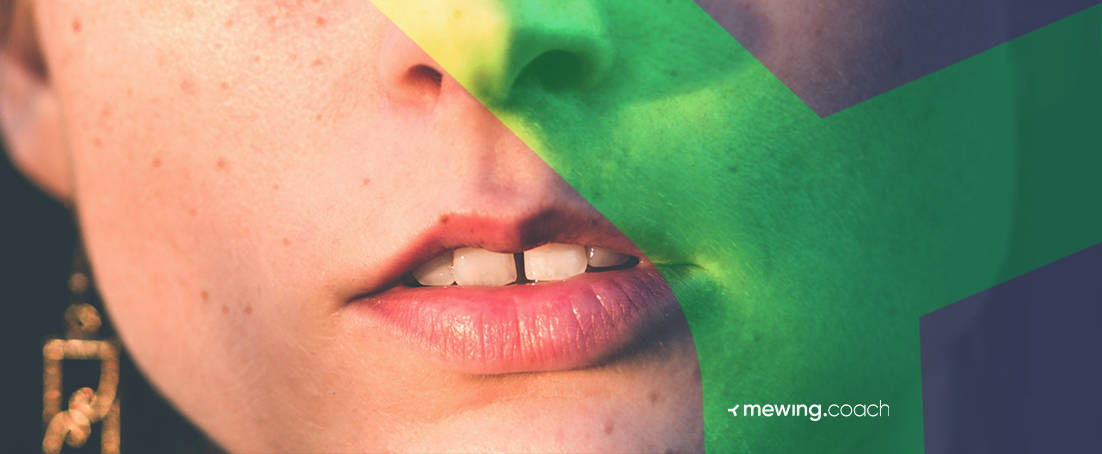
If you’re suffering from open mouth posture, it’s vital that you get to know the condition and find ways to treat it. Through effective treatment, you can avoid issues like mouth breathing, a misaligned bite, tooth decay, and more
In this article, we’ll discuss:
- 🔎 The symptoms and causes of OMP
- 📝 The risks of the condition
- 👩⚕️ Medical and at-home treatment options
Understanding the Open Mouth Resting Posture
Open mouth posture is a condition where the natural resting state of the mouth is improper. People dealing with the condition end up breathing through their mouth with their lips separated. The tongue of the person with OMP rests unnaturally in the oral cavity.
This type of oral posture can cause both structural, for example, a long face syndrome, and oral health issues such as bruxism, both of which can result in life-long problems. It’s most common in children, but adults can be affected as well.
Common Open Mouth Posture Causes
There are several different causes for this type of mouth posture. Some are due to habits formed over time, while others can be the result of known or unknown medical issues. The following are some of the most commonly found causes.
- Habitual Open Mouth Posture
Habitual open mouth posture is the result of repetitive behavior that requires the mouth to be open. Through it, after a while, the person’s mouth stays open due to habit, even when not in use. One example of such behavior can be thumb sucking in children.
- Orofacial Myofunctional Disorder
Orofacial Myofunctional Disorder is characterized by blocked nasal passages because of enlarged tonsils. This, in turn, forces the person to breathe through their mouth, keeping the mouth in an open position indefinitely.
- Nasal Obstruction
When your nose is blocked, your body’s natural response is to breathe through the mouth. For most people, this is something that stops when the nasal obstruction disappears.
However, open mouth breathing is a constant necessity when a person deals with chronic nasal obstruction due to nasal polyps, adenoids, or deviated nasal cavities.
- Other underlying medical conditions
A constant open mouth position can also be due to irregular front teeth, asthma, chronic allergies, face structure irregularities, and other medical conditions.
Risks of Untreated Open Mouth Posture
Maintaining a closed mouth posture is essential to proper oral health. No matter what the cause for your OMP is, the health hazards from the condition are always pretty similar.
Here are several health threats caused by OMP:
-
Dental Issues
Having dry air constantly introduced into the oral cavity damages your teeth. Crowded teeth, bite blocks, irregular front teeth, bruxism, and cavities can all be the result of not keeping the lips closed.
-
Facial Muscle Imbalances
A weak jawline isn’t always hereditary. Sometimes, a constantly opened mouth can have jawline asymmetry explained.
By not keeping the lips sealed, the facial muscles aren’t engaged and can weaken over time. This, in turn, can affect the overall jaw stability, especially in the lower jaw, resulting in an uneven jawline. This condition is also known as low tone.
-
Speech and Language Development Problems
The way a jaw develops plays a major role in the development of our speech abilities. Children with a habit of keeping their mouth open can be unable to produce certain sounds properly and will require special treatments.
-
Sleep Disordered Breathing
Snoring, hypopnea, and apnea are all considered to be a part of sleep disordered breathing (SDB) and a cause for a repeated open mouth posture. Given that we spend about a third of our lives sleeping, even if you keep your mouth closed during the day, the nightly mouth breathing will still affect your health.
Treatment Solutions for Open Mouth Posture
No matter what caused open mouth posture to develop, there are several ways to treat and fix it. The treatments can be invasive (surgical) and external (exercises). It all depends on the nature of the cause and your symptoms.
Orofacial Myofunctional Therapy
OMT is an individualized program that treats OMP through activities and exercises. It can help with the resting position of the tongue and lips, abnormal swallowing, low tone, and more.
Orthodontic Treatment
Orthodontic treatments include braces and Invisalign and can be very effective in treating OMP caused by teeth irregularities. By helping the teeth fall into the right places, braces and Invisalign help the lips purse easily.
Surgical Intervention
Surgical intervention is recommended for people who deal with OMP because of face structure irregularities, nasal deviations, inflamed tonsils, and other similar issues.
Mewing: One of the Most Effective Treatments for Open Mouth Posture
Another effective treatment option for OMP is mewing.
This technique was invented by an orthodontist and can help reshape your jaw, strengthen your face muscles, and eliminate your OMP.
How Mewing Helps
Mewing is essentially the practice of proper tongue posture. By engaging the tongue, it helps strengthen the overall face and naturalize a relaxed resting tongue position.
The technique also activates the jaw and cheek muscles and helps them become firmer and more sculpted. During the exercises, your lips are forced to remain pursed. This is how mewing affects lips divided by OMP and helps them maintain a closed position.
Given that OMP is often caused by mouth breathing and weakened muscles, it makes sense that exercises would help! Mewing is an excellent alternative for OMP caused by low tone, habits, orofacial myofunctional disorder, and more.
Learn How to Mew
If you’d like to learn how to mew properly, you can download an app, like Mewing.Coach. Through it, you can gain access to all the most effective exercises to help treat your OMP and sculpt your face.
Mewing.Coach offers customized mewing workout programs with video guidelines and is suitable for both children and adults.
By learning the mewing principles, you can take care of both the OMP itself and some of the underlying causes for it. For example, mewing effectively fights sleep apnea, a known cause for OMP. You can also mew to develop a proper tongue posture.
Treating OMP: Final Thoughts
There is a virtually endless array of pros in maintaining nasal breathing vs. mouth breathing – the lead OMP cause. Taking the time to develop proper breathing habits can transform the way you look and the state of your health.
We’d like to recommend mewing before any other form of treatment, especially if your OMP is habitual. The most aggressive treatment isn’t always the best way to go. Sometimes, all it takes is a little bit of regular exercise!




